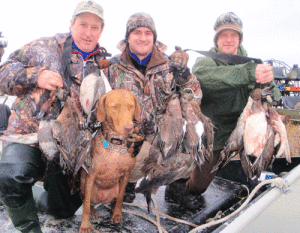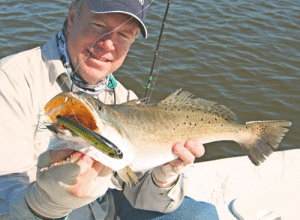
Successful duck hunting in Port O’Connor starts with a well brushed blind, a great decoy spread and some good calling.
Robert Sloan photo
There are three things you can do to bring in more ducks as we get further into the season. One is to brush up your blind as often as possible. The second thing is to wear full camo especially on your face and hands. Third – ease off the calling. At times subtle little quacks can be the ticket to success.
Of all the gear you can have for water fowling decoys are probably the most important. Without them you don’t stand much of a chance for a successful hunt, unless you happen to get in on some good pass shooting.
There are all sorts of decoys, and all are good in varying situations. Over the past several years motion decoys have been taking center stage.
If you plan on using something like a Mojo Mallard I highly recommend that you rig them about 5 to 10 feet above the water. Visibility is everything. I’ve made plenty of hunts with this type of decoy and they are deadly. But they definitely work best when rigged on a PVC pipe stand.
What I’ve noticed over the past couple of seasons is that ducks are becoming wise to electronic decoys. The best tactic is to have a remote control so you can turn them on and off. They seem to work best when ducks are out at about 50 to 100 yards. It’s the flash of the wings that get their attention. Once you have them coming in turn the decoy off, and work them in with a little bit of good calling. If they turn away, hit ‘em with a highball call and turn the decoy on.
Decoys are kind of like Scotch whisky – they get better with age. A shiny plastic decoy is not the best option. Real ducks don’t shine. It’s always best to touch up duck decoys with a little bit of paint. Fresh red paint on the head of a drake redhead is good. Ditto that with white on the head of widgeons, and on the breast of a drake pintail.
One other little trick that works really well is to set out about three magnum pintail decoys a few yards from the spread. That’ll help get the attention of high flying birds.
The main thing is to make sure your decoys are always in working order. There is nothing more frustrating than messing with tangled duck decoys a few minutes prior to shooting time.
With duck decoys it’s best to make sure they have good anchors, tangle free lines and can easily be tossed out.
Duck and Dove hunting dates:
Ducks – South Zone – Dec. 12 – Jan. 24, 2016, North Zone – Dec. 12 – Jan. 31, 2016
Doves – South Zone – Dec. 18 – Jan. 22, 2016, Central Zone – Dec. 18 – Jan. 1, 2016
For duck hunting trips and fishing charters call:
Capt. Robert Sloan, 409-782-6796, email – sloan288@aol.com or check out www.luckystrikeguide.com.

